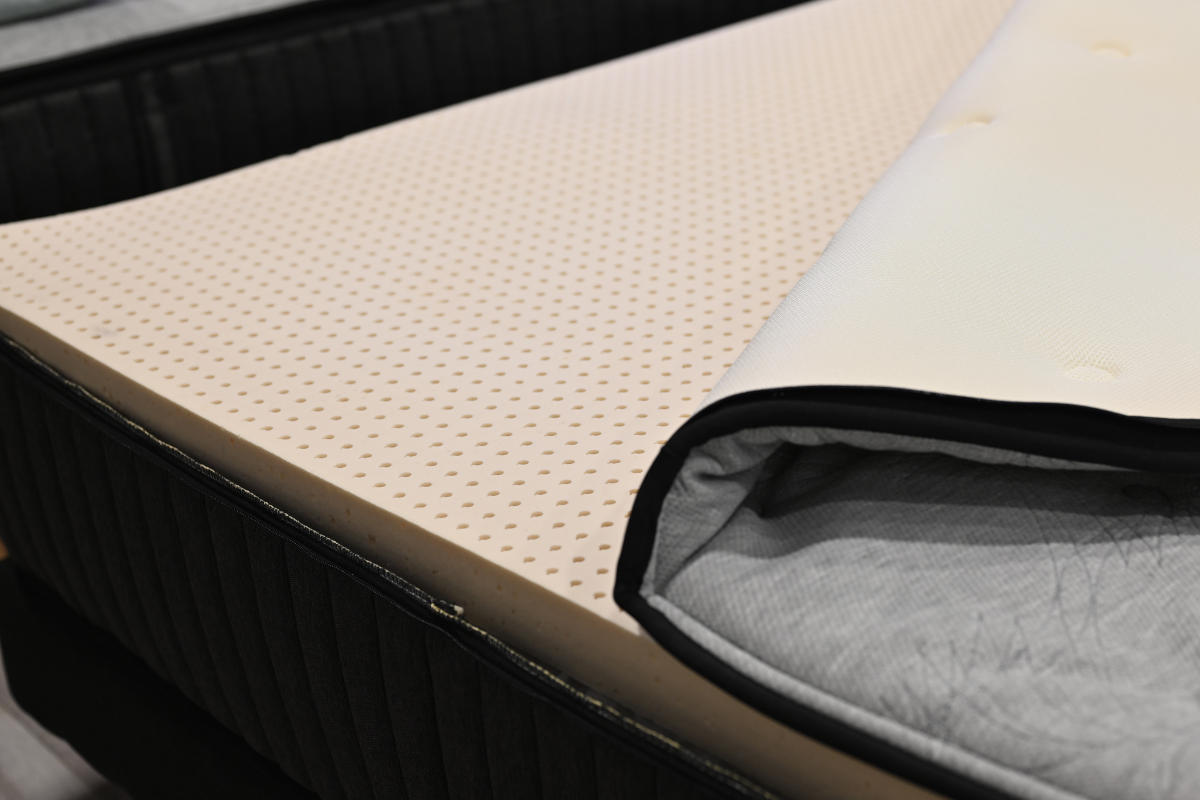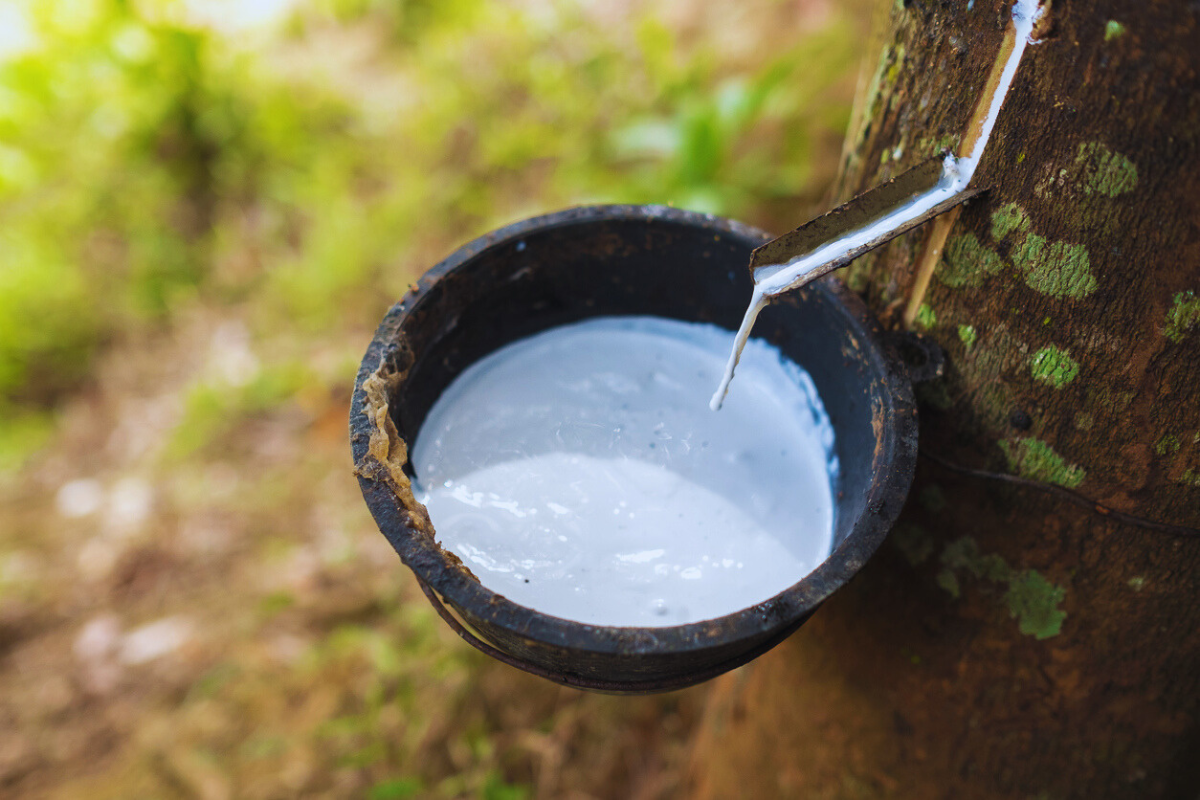The Truth About Natural Latex Mattresses: Don’t Fall for the 1cm Marketing Trick

The Latex Marketing Problem
Here’s something that’ll make you mad: a retailer can put 1cm of fake latex in a mattress and legally call it a “latex mattress.” I’ve seen it hundreds of times, and it’s pure marketing BS.
The problem? Most people don’t know what real latex actually is, so they can’t tell they’re being sold plastic with a latex sticker on it.
From someone that works with these materials all day, every day for over a decade, I can tell you the majority of “latex mattresses” out there are nothing of the sort. They’re foam mattresses with a token amount of synthetic latex thrown in so the marketing department can use the word.

What Real 100% Natural Latex Actually Is
Real natural latex is 95-97% pure sap from rubber trees (mostly from Malaysia, Sri Lanka, and Thailand). The remaining 3-5% are natural additives that make the liquid latex set properly during the baking process—without them, tree sap would just stay liquid.
This isn’t plastic. It’s not petroleum. It’s literally tree sap that’s been whipped up and baked in giant waffle moulds with metal rods running through them. Those rods heat up and cook the latex, which is why real latex has these distinctive 10mm holes running through it. If you want a mattress that actually uses this material, look at the Aurora, which contains a real 5cm latex layer on pocket springs.
Fake latex? That’s usually around 60% plastic-based foam (polyurethane). It has 4mm holes and feels completely different. It’s basically plastic foam with some latex mixed in.
How to Spot Fake Latex Foam
If you can see inside the mattress, look at the holes:
-
Real latex: 10mm holes (roughly pencil-width)
-
Fake latex: 4mm holes (roughly pen-tip size)
Also ask how thick the latex layer is. If they say 8-12mm, that’s a joke. Even if it were real latex (which it probably isn’t), you wouldn’t feel any meaningful benefit from that thin a layer.
I know right, I mean at this point it’s easy to fake—just make a mattress, put 1cm of fake latex in it and call it a latex mattress. The customer has no idea what they’re looking at, and the retailer gets to charge a premium for “latex.”
Why Retailers Use Minimal Latex
I’ll be honest—I don’t think retailers are evil. They’re just responding to business pressures. Real latex is expensive and incredibly difficult to source. When I order it, I have to:
-
Order an entire 20-foot container from Malaysia
-
Wait 3 months for delivery (used to be 6 weeks pre-COVID)
-
Store 200+ pieces in expensive warehouse space
-
Deal with limited size options based on mould dimensions
Plastic foam? I can order 3 pieces cut to exact specifications and have it arrive in 2 days.
Retailers pushing manufacturers for cheaper prices means latex gets squeezed out. It’s easier to slap in a token amount of fake latex and call it done. The majority of Retailers and bed-in-a-box are middle men and they use ads to get sales… They just see numbers, choose the cheaper foam, shave cost on the springs, make more money. Casper boxed mattress in USA went public and it was revealed that 30% of the sale price of the mattress was digital ad spend.
When companies spend 30%+ of your purchase price on advertising, they compensate by cutting material quality. That “latex” layer is often synthetic latex blend (not natural) or so thin it provides no durability benefit.
Latex done right.
Explore our range of locally made latex-over-pocket-spring mattresses - adjustable, durable, and built for real comfort.
Your Real Options for Natural Latex for Mattress
If you actually want the benefits of natural latex (durability, elasticity, longevity), you have two legitimate options:
Option 1: Go Big with Latex
Get a mattress with substantial latex layers—at least 5cm, preferably more. A 20cm slab of pure Dunlop latex will outlast almost anything else on the market. It’s heavy as hell and expensive, but it’ll last 20+ years if looked after.
But here’s the catch I see all the time: heat retention you can’t escape. To me, the more foam equals more heat. So I see a big lump of latex and think, hmm, that lump can absorb an awful lot of body heat. I understand the story that latex isn’t hot, but I don’t believe it. I believe less foam is the only way to reduce heat.
And there’s the contouring issue. What a lot of people experience with all-latex mattresses is why I don’t like them. There’s not enough contour so the shoulders don’t sink in. In order to get contour, you need well-designed pocket springs that are right for your body weight.
Option 2: Quality Hybrid (My Preference) - The Best Latex Mattress Approach
Get 5cm of real natural latex on top of quality pocket springs. This gives you the durability and feel of latex where it matters (the comfort layer you’re actually sleeping on) while keeping the mattress from being unreasonably heavy and expensive.
Latex on pocket springs to me is the best combination of materials for a mattress. This is why I made the Aurora.
Here’s why this approach works:
Minimal foam for maximum cooling
The more foam, the more heat. I use the minimum amount of foam possible. The latex is just there so you don’t feel the springs… If people ask me about what the coolest mattress is, I point to the spring unit. Below that 5cm of latex: air-filled springs that breathe naturally.
Springs do the heavy lifting
I use all the springs to get the comfort right. Then the foam is only there, so you don’t feel the springs. In this case, the latex really moulds to the pocket springs underneath so the shoulders and hips can sink right in.
In my Aurora mattress, I use:
-
5cm natural Dunlop latex (97% rubber tree sap, 70 kg/m³ density)
-
1,600 micro springs (Queen) / 1,800 (King) for contouring
-
986 honeycomb pocket springs (Queen) / 1,160 (King) body-weight matched
-
Total: 2,586 springs working together (Queen)
The Cloud adds a second layer of micro springs (3,200 total for Queen) for even more conforming comfort.
Proven durability
I had models where the entire mattress was the same, only the 5cms of foam on top was different… Latex, very few issues, memory lots of issues. Pretty simple. I pull apart old mattresses. Memory foam is always very soft around the hip area. It’s worse than polyfoam ‘usually’, latex just destroys both of them it’s not close.
One customer who switched from an all-latex setup told me: “I spent days trying to decipher what the layers were in the major companies mattresses, and hours laying on different mattresses. The one I liked the most was an $8,800 mattress… I took a chance with Ausbeds… within days my shoulder pain was gone and my neck pain is gone (side sleeper).” — Dan M., Aurora Queen
What This Actually Costs
I like to keep things simple as this mattress stuff is complex enough. Here’s what you’re looking at for natural latex on properly engineered springs without retail markup:
Aurora (Latex + Micro Springs + Pocket Springs):
-
Queen: $2,450 (2,586 total springs)
-
King: $2,750 (2,960 total springs)
Cloud (Double Micro Springs for Maximum Plushness):
-
Queen: $2,940 (4,186 total springs)
-
King: $3,190 (4,760 total springs)
Includes 3-9 month trial period, 10-year warranty, 2 free component swaps in first 3 months, body-weight matched springs, handcrafted in Sydney.
Compare that to retail “latex” mattresses at $5,000-$10,000+ with 600 springs and 1cm of fake latex. I once ran out of springs and rang someone to use his pocket springs. It turned out there was only 600 pocket springs in the unit. I got so many returns after that. That’s when I realized that if I was getting more returns from having less turns and fewer springs, maybe if I increased the turns and the springs I would get even less returns.
The Bottom Line
Just make sure that if someone’s selling you “latex,” they can show you it’s actually latex—not 1cm of plastic foam with a fancy name. Ask to see the holes (10mm for real, 4mm for fake). Ask how thick the layer is (minimum 5cm for any real benefit). And ask yourself whether you want a heat-trapping slab of foam or latex where it matters on springs that actually contour to your body.
All just my opinion of course, but I do this every single day and I hear the same stories over and over. Let me know how it goes :)
Visit the Marrickville factory-showroom to feel the difference: 136 Victoria Road, Marrickville NSW 2204 (Mon-Fri 10am-6pm, Weekends 10am-2pm)
Frequently Asked Questions
About the author

Karl is the owner of Ausbeds. He started the company after realising how many people were frustrated by mattresses that failed too soon and too often. So he built a workshop in Sydney and began making mattresses the way they should be made - with transparent materials, adjustable designs, and customer-first thinking. When he's not in the showroom/workshop, he's on Reddit, Whirlpool, and OzBargain, cutting through industry fluff with honest mattress advice.



